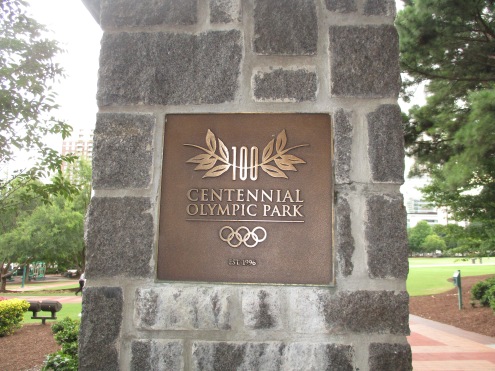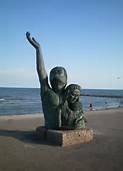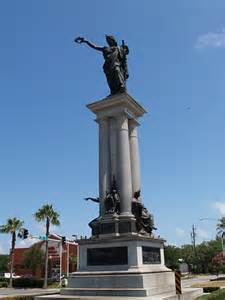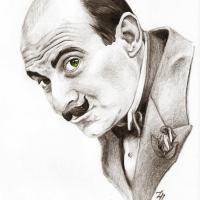My Trip to Atlanta – Part Two
Centennial Olympic Park
Maybe it’s because this was an Olympic year and I just introduced my daughter to the joys of binge watching the best gymnasts in the world blow everyone’s minds. Maybe it’s because it was the twenty year anniversary of the night Keri Strug wowed us all with her stellar commitment to herself and her team. Maybe it’s just because I like parks…
 My favorite part of Atlanta – the city, not the trip – was Centennial Olympic Park. I had to walk through it every day to get to the Vendor’s Hall for Dragon Con; and I am so glad I did.
My favorite part of Atlanta – the city, not the trip – was Centennial Olympic Park. I had to walk through it every day to get to the Vendor’s Hall for Dragon Con; and I am so glad I did.
Atlanta as a whole had a wild, unkempt feel to me, sporadically blasted with moments of finely controlled beauty. I’d walk from Joseph E. Boone, where the grass I think, had never been cut, to stepping into the symbol of perfection itself: Centennial Olympic Park.
 Honestly, I enjoyed the contrast. As an environmentally friendly foraging hippie, I loved that the lawns were more like meadows. I found joy in poking along overgrown sidewalks with the opportunity to inspect local wildflowers. I even found a luna moth one morning, something I had never seen in person before.
Honestly, I enjoyed the contrast. As an environmentally friendly foraging hippie, I loved that the lawns were more like meadows. I found joy in poking along overgrown sidewalks with the opportunity to inspect local wildflowers. I even found a luna moth one morning, something I had never seen in person before.
But as a lover of community parks, I also found myself drawn to the twenty-eight million dollar completed project. City cleaners sweep, scrub, and constantly pick up trash, keeping the park immaculate. The statues seem to gleam, both from their artistic beauty and the city’s over all effort to maintain “curb appeal.” I found myself wondering what was there before 1996 and learned that it was a city block of old industrial buildings, some abandoned. The difference to Atlanta citizens when the park was first erected must have been startling.
 I stopped to take pictures of some of the statues when I was there. I got some curious looks before people started stopping and taking pictures too. “Sheep” my friend called them, but I think it just takes someone noticing something beautiful before others stop and look up. And the monuments there are very beautiful.
I stopped to take pictures of some of the statues when I was there. I got some curious looks before people started stopping and taking pictures too. “Sheep” my friend called them, but I think it just takes someone noticing something beautiful before others stop and look up. And the monuments there are very beautiful.
Each morning I would cut across a paved walkway made of engraved stones to get to John Portman Blvd. During the park’s construction a donation of $35 got you a stone and a message. When I return to Atlanta, because I plan to, I’d like to pay more attention to those engravings. There are stories there, I think.
 The weather was gorgeous. People (Yankees! Haha) kept talking about how hot it was. I was wearing a sweater most days, not the afternoons, but definitely in the mornings. My morning walks were the most refreshing parts of my day. I meant to stop and eat breakfast at the Waffle House right outside the park, but never managed to wake up early enough – or if I did, I found myself dawdling in the park instead. So, I spoiled myself and got coffee at the Starbucks in the AmericasMart. I kept looking for a local Non-Starbucks coffeehouse, but didn’t find one; again, next trip.
The weather was gorgeous. People (Yankees! Haha) kept talking about how hot it was. I was wearing a sweater most days, not the afternoons, but definitely in the mornings. My morning walks were the most refreshing parts of my day. I meant to stop and eat breakfast at the Waffle House right outside the park, but never managed to wake up early enough – or if I did, I found myself dawdling in the park instead. So, I spoiled myself and got coffee at the Starbucks in the AmericasMart. I kept looking for a local Non-Starbucks coffeehouse, but didn’t find one; again, next trip.
Miraflores
We saw it from the road when we were on our way to a bookstore. It was on the right (off Hildebrand, on our way to Broadway, I think) and I would have missed it behind the construction cones along the road and the gritty chain link National Rent-a-Fence. But the gates loomed, demanding to be seen. The statues looking like mysterious cemetery pieces, but alas, there were no tombstones.
We passed it several times and weren’t actually able to go investigate until our last day there.
 First we stopped at an old Spanish mission (turned greeting center, perhaps?) with a San Antonio Zoo sign perched near the steps. I suppose we were on the backside of the zoo, or maybe it wasn’t even open, but we found ourselves in a beautiful park.
First we stopped at an old Spanish mission (turned greeting center, perhaps?) with a San Antonio Zoo sign perched near the steps. I suppose we were on the backside of the zoo, or maybe it wasn’t even open, but we found ourselves in a beautiful park.
There were families, and ducks, and families of ducks. But ultimately that ‘cemetery’ was calling our names and we had to go see it. We drove back to the main street and lamented the fence. We entered the parking lot to elsewhere and lamented the fence. Then, we saw that the chain link gate was ajar. Left for someone to go in and out for the day? We determined that it must be open by day and locked up at night to keep out the riffraff. So, cameras in hand, we entered Miraflores, not knowing its name, and explored.
 We found the Doctor’s name on several of the tiled benches. To my uninformed eye there was no way for me to know they were designed by Atlee B Ayres, famous San Antonio architect. I just knew they were beautiful and that they were made in honor of or for a Doctor, as the letters were mostly chipped away. Later, we would see the name Urrutia on the gates. There, in the mosaics of those grand gates, his name remained in tact and I took yet another photograph. I skipped jotting down the information in my journal for the sake of spending that precious time getting more photographs. Even though I thought it was ok to be there, something about the whole experience felt a bit like we had discovered a magic-hour of sorts and I didn’t want to waste a moment.
We found the Doctor’s name on several of the tiled benches. To my uninformed eye there was no way for me to know they were designed by Atlee B Ayres, famous San Antonio architect. I just knew they were beautiful and that they were made in honor of or for a Doctor, as the letters were mostly chipped away. Later, we would see the name Urrutia on the gates. There, in the mosaics of those grand gates, his name remained in tact and I took yet another photograph. I skipped jotting down the information in my journal for the sake of spending that precious time getting more photographs. Even though I thought it was ok to be there, something about the whole experience felt a bit like we had discovered a magic-hour of sorts and I didn’t want to waste a moment.
 Though, I could spend hours there writing. What I wanted to do more than anything was stay there all day and document every fragmented tile. I longed for a library to access and investigate each piece of art and how it came to be gathered in this statuary field. The gate said the “institute” was founded by Doctor Urrutia in 1921. What institute? Who was Doctor Urrutia? What was the plan for this acreage?
Though, I could spend hours there writing. What I wanted to do more than anything was stay there all day and document every fragmented tile. I longed for a library to access and investigate each piece of art and how it came to be gathered in this statuary field. The gate said the “institute” was founded by Doctor Urrutia in 1921. What institute? Who was Doctor Urrutia? What was the plan for this acreage?
 Dr. Urrutia arrived in the States from Mexico in 1915 – as an exile. He was born in the town “of floating gardens” just south of Mexico City and was a full-blooded Aztec Indian. He went to medical school, graduated top of his class, and by the age of 22 was the President’s personal physician. In 1910 Presidente Diaz was replaced by Madero, who was then killed and replaced by Huerta. In all this killing and backstabbing, Huerta had got himself stabbed in the eye, and it was Urrutia who operated on him. Then, according to Walt Lockley, Urrutia functioned a bit like a puppet master for the gangster and helped him run the country.
Dr. Urrutia arrived in the States from Mexico in 1915 – as an exile. He was born in the town “of floating gardens” just south of Mexico City and was a full-blooded Aztec Indian. He went to medical school, graduated top of his class, and by the age of 22 was the President’s personal physician. In 1910 Presidente Diaz was replaced by Madero, who was then killed and replaced by Huerta. In all this killing and backstabbing, Huerta had got himself stabbed in the eye, and it was Urrutia who operated on him. Then, according to Walt Lockley, Urrutia functioned a bit like a puppet master for the gangster and helped him run the country.
What happened next is a biography worth reading in itself:
But after dark, Urrutia was also accused of a medical assassination – a federal senator from Chiapas who publicly spoke against Huerta, Belisario Dominguez, was arrested as an enemy of the government, in the Jardin Hotel, on October 7, 1913, then taken to a cemetery, where dark persistent rumor has it that Dr. Urrutia cut out his tongue.
Without anesthetic.
Huerta threw eighty congressmen into prison at one point. Urrutia himself issued an ill-advised ultimatum to the US government, wanting official recognition, and Woodrow Wilson responded with battleships to Veracruz. In the late summer of 1914, as this government fell apart, a lot of the Huertistas and the well-to-do and ex-governors and henchmen drained out through Veracruz. Dr. Urrutia was arrested there by General Frederick Funston and was allowed to exile himself to the US: by ship from Veracruz to New Orleans, train from New Orleans to San Antonio, and two rail cars of treasure smuggled across the border later, to finance his new American life and humanitarian career.
– Walt Lockley
Urrutia died in 1975 at the age of 103, in his sleep, at his grand 15 acre estate in San Antonio. But before that would happen, he would be the first doctor to separate Siamese twins in Texas and he would build something marvelous: Miraflores. And I got to traipse around its remains.
 Other artists contributed to this historic monument. According to Capturing Nature
Other artists contributed to this historic monument. According to Capturing Nature, Dionicio Rodriguez is responsible for the ‘rocks’ on the gates, but I’m not sure which aspect ‘rocks’ refers to.
In 2004, the area was added to The National Register of Historic Places, primarily for Rodriguez’s contributions. It is thought that Miraflores contains his earliest work in the states as well as the “most intact and concentrated groupings” of his work. One of those pieces is actually an extremely unique foot bridge in Breckenridge Park that caught our eyes several times.
The blog Urban Spotlight San Antonio describes a plan, in a post dated 2009, that would make the park open to the public. We saw the bridge from Breckenridge Park the post describes, but the public pedestrian walkway was blocked off and locked. I am still unsure if the entrance I used was meant for the public or not. Either way, I am glad I used it and got a chance to see so many beautiful works of art up close. (There’s an extensive history included in that post regarding who owned the property during which decades and how they used it. It’s quite interesting.)
According to SA Cultural Tours:
Much of the statuary originally designed for the park has been lost or damaged over the past several decades. Remaining features include the tiled entrance gates along Hildebrand, designed by Mexican artist Marcelo Izaguirre, as well as the 1946 statue of Dr. Urrutia that originally stood in the center of a large pool. […] The park originally featured a small tower building housing Dr. Urrutia’s library, but it has been demolished. The small remaining cottage, Quinta Maria, was built in 1923 as a guest house. Statuary moved to the park in the 1960s following the demolition of Dr. Urrutia’s nearby home include the Winged Victory with crouching lions, and the replica of Coyolxauhqui, the Aztec moon goddess.
I think my favorite… the place where I could sit for hours and reflect and write… would be near Cuautemoc. He is the last ruler of the Aztecs, extremely energetic, and makes me feel mighty and safe.
Luis L. Sanchez designed him in 1921, and it’s one of the most impressive statues I have seen in person, just for the sheer power it seems to radiate, like Achilles.
I love that Urrutia chose to include him in his garden. Regardless of the sinister rumors that still surround Urrutia and his political dealings – including this statue in his place of exile says a lot about his passions and his identity. He respected his heritage, his elders, and the past. He had a taste for art, I think, I cannot bring myself to believe that he did this for the mere sake of showing off his money. He had a library that has not survived, and clearly had a thirst for knowledge and legacy.
After many business deals and exchanging of hands, The University of Incarnate Word now stands where Urrutia wanted a hospital. The San Antonio Express reported in 1929 that Urrutia’s “grand ambition is to found a hospital here which will perpetuate his work … a hospital composed of pleasant, homelike bungalows surrounded by flowered lawns, clustered around a central House of Administration. For this purpose, he has bought an extensive piece of property on Broadway and Hildebrand.” It sounds to me as though he sought some gentle peace after his years in Mexican politics.
However, Urrutia’s “institution” remained a private garden for hosting his family and parties, for morning excursions to swim laps in the pools, and to feed his peacocks while wearing his infamous cape. I’m a little sorry the property never became exactly like he dreamed, but am glad he put forth the effort to get the gardens going.
Sun-Burned Days
 We went to the beach yesterday. It was amazing. We played in the sun, splashed in the waves, built sand castles with moats and walls and invading armies. We applied sunblock every 30 minutes to our fair-fair skin – spf 50. And in between those moments sprayed another kind of sunblock over our whole body to ensure that I hadn’t missed any spots.
We went to the beach yesterday. It was amazing. We played in the sun, splashed in the waves, built sand castles with moats and walls and invading armies. We applied sunblock every 30 minutes to our fair-fair skin – spf 50. And in between those moments sprayed another kind of sunblock over our whole body to ensure that I hadn’t missed any spots.
Nonetheless, today we are burnt. Really burnt. Ok, so kiddo is moderately burnt and my legs look like lobster legs.
These are the days when being a reader and quasi hermit come in handy… we are sitting in the cool of the house watching book-based movies (The Rise of the Guardians) and patting our body parts down with home remedies.
So far, it has been a steady application of vinegar water (to take the heat out), egg whites (to minimize the blistering), aloe vera (because everyone knows to use aloe!), and at some point today I plan to try out a black tea poultice but that will require me to go purchase some Earl Gray. Frankly, neither one of us wants to leave the house.
Prior to all this excitement (or miserable post-beach adventurism) however, I was seriously looking into the idea of moving closer to the shoreline. (I’m still thinking I want to add this to my bucket list.) If only for a 6 month lease someday.
 Galveston in particular is full of a rich history that I was briefly introduced to in school, mostly surrounding the epic flood of 1900 and the statue memorializing that event. I remember studying the great September 8th flood in both fourth grade and seventh grade. I even wrote a fictional diary of a girl caught in the flood as part of a required creative writing exercise. With 145 mile an hour winds, near total destruction, families lost and killed, I sort of believed it wasn’t a viable living option. Despite it being a great place to visit for the day, when Ike hit, I was still surprised to learn that people actually live on the island year round. I grew up believing it was a Houstonian’s day trip destination and nothing more.
Galveston in particular is full of a rich history that I was briefly introduced to in school, mostly surrounding the epic flood of 1900 and the statue memorializing that event. I remember studying the great September 8th flood in both fourth grade and seventh grade. I even wrote a fictional diary of a girl caught in the flood as part of a required creative writing exercise. With 145 mile an hour winds, near total destruction, families lost and killed, I sort of believed it wasn’t a viable living option. Despite it being a great place to visit for the day, when Ike hit, I was still surprised to learn that people actually live on the island year round. I grew up believing it was a Houstonian’s day trip destination and nothing more.
 One in particular that amazed me this weekend was the statue regarding the Texas Revolution. It’s huge, and gorgeous, and well worth a child’s research paper. Despite all the intense Texas History a child is submitted to as a ward of the Texas public education system, I had completely been unaware (or merely forgot) that Galveston was the Republic of Texas’ capital city.
One in particular that amazed me this weekend was the statue regarding the Texas Revolution. It’s huge, and gorgeous, and well worth a child’s research paper. Despite all the intense Texas History a child is submitted to as a ward of the Texas public education system, I had completely been unaware (or merely forgot) that Galveston was the Republic of Texas’ capital city.
I definitely want to incorporate more beach trips into our lives – despite our fair skin and my current severe sun burn. But if I were to ever live there for a few months or so with our kiddo, I have so many cool lessons plans already half built around what would become our daily schedule. Just the architecture alone is worth a good week’s worth of study.
The whole day was a gentle reminder to be a tourist in your own city from time to time. It can be highly educational.
Until then, maybe we’ll check out some Books about Galveston Island.














